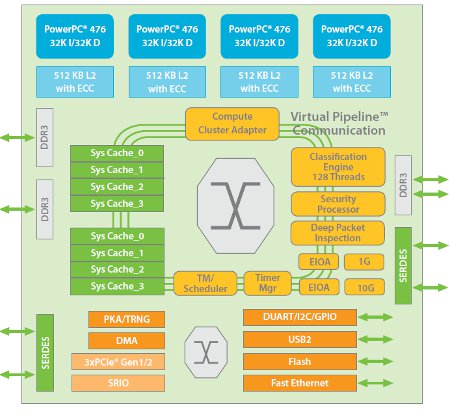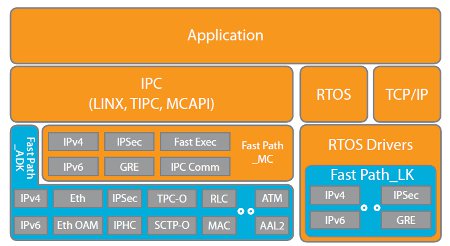Multicore PowerPC networking SoCs gain Linux support
Jun 29, 2010 — by Eric Brown — from the LinuxDevices Archive — 16 viewsWind River announced a multi-year collaboration with LSI to co-market “tightly integrated” Linux-ready hardware and software for LSI's PowerPC-based, multicore Axxia Communication Processors (ACP). Targeting telecommunications and networking infrastructure, the partners' solutions will include Axxia-optimized board support packages (BSPs) for Wind River Linux, VxWorks, Wind River Workbench, and Workbench On-Chip Debugging, says the company.
The Axxia collaboration involves alignment of long-term product roadmaps, sales and marketing, engineering resources, and professional services, says Wind River. The BSPs and related products will support "the wide spectrum of network elements that network equipment providers can use to develop, optimize and test new wireless, wireline, and enterprise elements," says the Intel subisidiary.
The support products will be built around Wind River Linux and the Wind River VxWorks real-time operating system (RTOS) embedded distributions, says the company. Also said to be supported are Wind River Workbench, and the integrated Workbench On-Chip Debugging, which recently added multicore and multitarget support.
Announced in February, the Axxia Communication Processors (ACP) are touted for their ability to manage large volumes of wireless traffic at wirespeed while delivering highly deterministic performance. The initial, currently available ACP3448 model is capable of 20Gbps performance on wireless infrastructure, while future Axxia models will scale to up to 100Gbps performance, claims LSI.

Axxia Communication Processor (ACP3448) block diagram
(Click to enlarge)
LSI Virtual Pipeline touted for inter-chip communications
The Axxia SoC is said to be packed with intelligent offload engines, including packet classification, traffic management, security processing, and deep packet inspection engines. These engines and other on-chip processing elements are linked using a new "LSI Virtual Pipeline" message-passing technology equipped with deterministic modeling and distributed queue management.
The LSI Virtual Pipeline interconnect technology optimizes inter-processor message routing, resulting in improved efficiency and less on-chip traffic congestion, claims LSI. The technology is touted for offering wirespeed security processing without affecting CPU load. It is also said to enable network operators to better manage traffic congestion in real time, improving response time and quality of service.
The ACP3448 features serial high-speed interfaces including eight SerDes-based SGMII, dual XAUI-based 10 gigabit Ethernet, and x1/x4 Serial RapidIO (SRIO) capable of speeds of up to 3.125Gbps, says LSI. In addition, x1/x2/x4 PCI Express is offered at up to 5Gbps per lane at up to three ports, says the company. Standard interfaces are said to include USB, Fast Ethernet, I2C, GPIO, and flash memory.
Lower-end Axxia models
Other Axxia SoCs being readied by LSI include a low-end ACP3421 model claimed to support 5Gbps performance. The ACP3421 offers two 1.6GHz cores, 1MB L2 cache, and 2MB system cache, says LSI.
There is also a mid-range ACP3442 supporting 5-10Gbps. Like the ACP3448, it is equipped with four 1.8GHz cores and has 2MB L2 cache, but offers only 2MB system cache, says the company.
Linux BSPs and an IDE
Aside from the upcoming Wind River support solutions for Linux and VxWorks, the Axxia SoCs are offered with turn-key application development kit (ADK) modules, run-time environment application programming interfaces (APIs), software modules, and BSPs for Linux and Enea OSE platforms. The support tools are designed "to rapidly develop software for wireless applications," says LSI.

Axxia software architecture
(Click to enlarge)
Stated Mike Langlois, GM for networking and telecommunications at Wind River, "Wind River and LSI are working to achieve greater levels of performance to address the explosion of wireless data traffic and the need for increased network intelligence."
Stated Charlie Kawwas, VP of sales and marketing for Semiconductor Solutions Group at LSI, "Forming a strategic relationship with Wind River brings together best-in-class multicore hardware and software platform solutions our mutual customers can use to develop highly competitive next generation wireless, wireline and enterprise products."
Availability
No details were offered on the availability of the Wind River solutions for LSI's Axxia processors. The LSI ACP3448 appears to be available now. More information on the Axia processors may be found in a PDF datasheet, here.
This article was originally published on LinuxDevices.com and has been donated to the open source community by QuinStreet Inc. Please visit LinuxToday.com for up-to-date news and articles about Linux and open source.